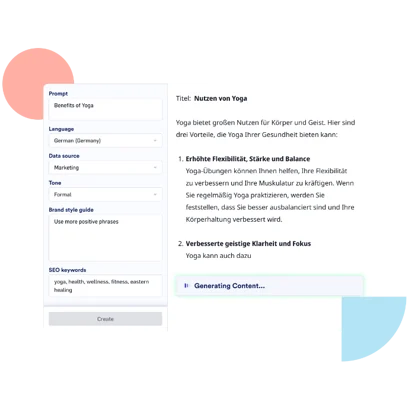Industry
July 19, 2023
Tips to Write Effective LLM Prompts and Generate Multilingual Content
Anyone working on content or translation knows how powerful and effective language can be. Whether it's crafting engaging blog posts, optimizing SEO strategies, or scaling local campaigns, the right words are powerful enough to make a significant impact..
Han Mai
Associate Director, Demand Generation

Anyone working on content or translation knows how powerful and effective language can be. Whether it's crafting engaging blog posts, optimizing SEO strategies, or scaling local campaigns, the right words are powerful enough to make a significant impact on reach and engagement.
Today, large language models (LLMs) and generative AI like LILT Create, ChatGPT, and Writer are becoming increasingly powerful tools for generating content. Businesses and individuals are now more empowered than ever to access advanced tools for generating multilingual content. However, it's not enough to simply rely on the LLMs. To get the most out of them, you must use the right language—and that's where prompt engineering comes in.
How Can I Get Started?

Today, large language models (LLMs) and generative AI like LILT Create, ChatGPT, and Writer are becoming increasingly powerful tools for generating content. Businesses and individuals are now more empowered than ever to access advanced tools for generating multilingual content. However, it's not enough to simply rely on the LLMs. To get the most out of them, you must use the right language—and that's where prompt engineering comes in.
What is Prompt Engineering?
Prompt engineering is the process of creating precise and effective inputs for AI systems. In the context of LLMs, this means using specific language and instructions to guide the model to generate the desired output. There are a number of best practices for prompting LLMs to write multilingual content including:
- Use clear and descriptive language. The language used in the prompt should be clear and descriptive, so that the model can easily understand what is being asked. One tip that works well when writing prompts for LILT Create is assigning a role to the model. For example, you can add context to the prompt by saying, "As a Product Manager with years of experience, write this."
Another best practice is to define the parameters of the output. For example, you can add instructions like, "The article should be concise. Do not use jargon, and write it in a way that <X> can understand it and learn from it." - Be specific. The more specific you are in your prompt, the more likely the model will generate the desired output. For example, instead of saying, "Write a blog post about LLMs," you could say, "Write a blog post about the benefits of using LLMs for multilingual content generation." • Use examples: Providing examples of the desired output can help the model to learn what is expected.
• Use negative examples: In addition to providing positive examples, you can also provide negative examples to help the model learn what not to do. For example, if you are trying to prompt the model to write a blog post about the benefits of using LLMs for multilingual content generation, you could also provide negative examples of blog posts that do not discuss the benefits of using LLMs. - Leverage keywords. Using keywords in your prompts can help the model to focus on the right information. For example, if you are trying to prompt the model to write a blog post about the benefits of using LLMs for multilingual content generation, you could include keywords such as "LLMs," "multilingual content," and "benefits."
- Integrate a style guide. A style guide can be used to help the model conform to the conventions of a specific voice or tone. This can help generate multilingual content that is aligned with other content you have authored within a given writing style or for a target audience. With LILT Create, you can easily import your brand and style guidelines to ensure consistency and alignment across all languages.
- Use a data source. Selecting a data source from your existing assets is the best way to supercharge your content generation. Your data sources will contain all of your previously translated content and help systems like LILT Create.
- Try a variety of prompts. Most importantly, be patient! It will take some trial and error to find the right prompts for your needs. Keep experimenting with different prompts can help to find the ones that work best for a particular task.
Popular Techniques for Prompts
In addition to these general best practices, there are a number of specific techniques that can be used to prompt LLMs and generative AI tools like LILT Create to write multilingual content. These techniques include:
- Zero-Shot PromptingThis involves simply asking the model to generate multilingual content without providing any prior training or examples.Example prompt: Write a blog post about the benefits of using LLMs for multilingual content generation.
- Few-Shot PromptingThis involves providing the model with a few examples which it will try to adhere to when generating multilingual content. It’s a good choice when it is harder to describe what you want than showing an example.Example prompt: Here are a few examples of blog posts about the benefits of using LLMs for multilingual content generation. Write a blog post that is similar to these examples, but that also includes your own insights and ideas.• "How LLMs Are Revolutionizing Multilingual Content Generation"
• "The Benefits of Using LLMs for Translating Content into Multiple Languages"
• "How LLMs Are Making it Easier to Create Multilingual Content" - ReAct PromptingThis involves prompting the model to generate both reasoning and task-specific actions in a unified manner.Example prompt: Prompt the model to generate both the content of the blog post and the steps involved in creating the content. The model should use a logical chain of reasoning to generate the content and the steps.
Those are just a handful of strategies for prompting. Other approaches, such as Chain-of-thought (CoT) prompting and self-reflection, are also popular techniques that are worth exploring and experimenting with.
Prompt engineering is a powerful tool that can be used to improve the performance of LLMs. By following the best practices and using the appropriate techniques, it is possible to effectively prompt LLMs to write multilingual content. This can be a valuable tool for businesses and individuals who need to generate multilingual content quickly and efficiently. Learn how you can prompt LILT Create to write content in any language or sign up for a free trial.
Share this post
Find some time with LILT
Enterprise-grade content seamlessly translated with AI to help your business scale globally.
Book a MeetingShare this post